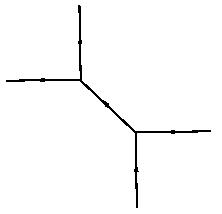
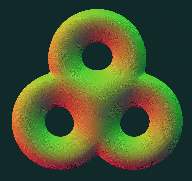
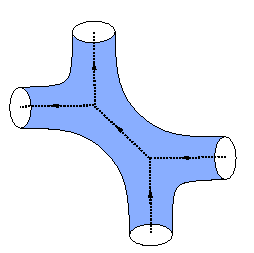
String Theory
What is string theory?
String theory is at this moment the most promising
candidate theory for a unified description of the fundamental particles
and forces in nature including gravity. As a theory of quantum gravity string
theory is at present our best hope to give concretely computable answers to
fundamental questions such as the underlying symmetries of nature, the quantum
behaviour of black holes, the existence and breaking of supersymmetry, and the
quantum treatment of singularities. It might also shed light upon larger issues
such as the nature of quantum mechanics and space and time. In string theory all
the forces and particles emerge in an elegant geometrical way, realizing
Einstein's dream of building everything from the geometry of space-time.
String theory is based on the (deceptively simple) premise that at Planckian
scales, where the quantum effects of gravity are strong, particles are actually
one-dimensional extended objects. Just as a particle that moves through
spacetime sweeps out a curve (the worldline)
string will sweep out a surface (the world-sheet)

In contrast with particle theories, string theory is highly constrained in
the choice of interactions, supersymmetries and gauge groups. In fact, all the
usual particles emerge as excitations of the string and the interactions are
simply given by the geometric splitting and joining of these strings:
In this way the usual Feynman diagrams of quantum field theory are
generalized by arbitrary Riemann surfaces
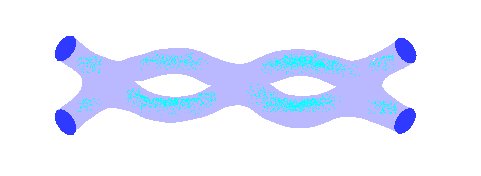
Much recent interest has been focused on D-branes. A D-brane is a submanifold
of space-time with the property that strings can end or begin on it.
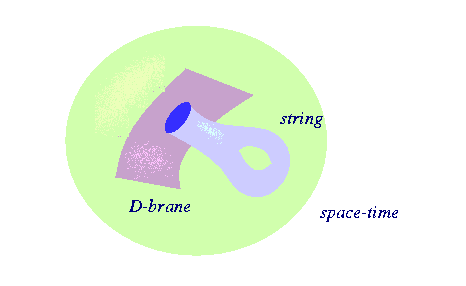
More information on the web
Some recent popular literature on string theory
- G. Taubes, A Theory of Everything Takes Shape, Science 269 (1995).
- P. Townsend, Unity from Duality, Physics World, Sept 1995.
- E. Witten, Reflections on the Fate of Spacetime, Physics Today, April
1996.
- M. Mukerjee, Explaining everything, Scientific American, January 1996.
Good starting points in the scientific literature
- M.B. Green, J.H. Schwarz, E. Witten, Superstring Theory, two volumes
(Cambridge University Press, 1987).
Still the most complete treatment of the pre-1987 material.
- J. Polchinski, What is String Theory? in Les Houches 1994,
`Fluctuating Geometries in Statistical Mechanics and Field Theory,' hep-th/9409168.
A good review of the material that ends just before the
`1994 revolution.' It also includes the matrix models and random surface
ideas of 1989/90.
- J. Polchinski, Tasi Lectures on D-branes, hep-th/9611050.
All you want to know about D-branes, the single most
important ingredient to understand non-perturbative string theory.
- B. Greene, String Theory on Calabi-Yau Manifolds, hep-th/9702155.
A excellent review of (super)conformal field theory,
supersymmetric sigma models, mirror symmetry etc.
- H. Ooguri, Z. Yin, TASI Lectures on Perturbative String Theory,
hep-th/9612254.
A compact lecture series that treats the essentials of
perturbative string theory in an elegant way.
- R. Dijkgraaf, Les Houches Lectures on Fields, Strings and Duality,
to be published in Les Houches 1995, `Quantum Symmetries.' hep-th/9703136
My lecture notes on the more mathematical aspects of
modern quantum field theory and strings.
- T. Banks, Matrix Theory, hep-th/9710231.
A review of matrix theory, at this moment the hot topic in
string theory.
Links
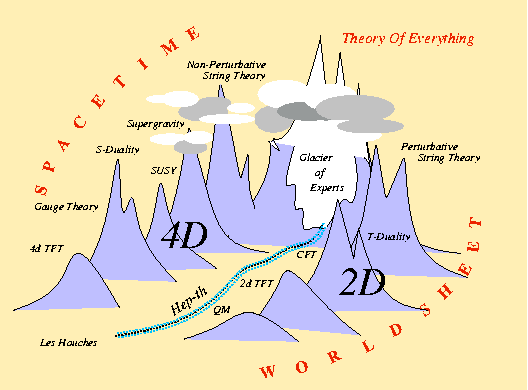
Map of the world, as used in my Les Houches lectures
Maintained by: rhd@wins.uva.nl
Last modified: 7 Nov 1997









